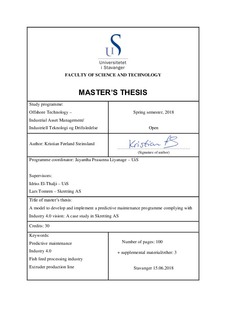| dc.contributor.advisor | El-Thalji, Idriss | |
| dc.contributor.advisor | Tomren, Lars | |
| dc.contributor.author | Steinsland, Kristian Førland | |
| dc.coverage.spatial | Norway | nb_NO |
| dc.date.accessioned | 2018-11-09T09:25:04Z | |
| dc.date.available | 2018-11-09T09:25:04Z | |
| dc.date.issued | 2018-06 | |
| dc.identifier.uri | http://hdl.handle.net/11250/2571736 | |
| dc.description | Master's thesis in Offshore Technology : Industrial Asset Management | nb_NO |
| dc.description.abstract | Industry 4.0 is among related terms a buzzword in today’s industry. It is clear that several technologies aim to enable operators to obtain better control of their production operations, avoid non/added value events e.g. failures, stoppages, cut the operating and maintenance cost, and extend the asset lifetime. All these benefits are achieved by collecting and analyzing data in a smart i.e. automated manner. However, there are four main challenges to achieve such transformation (lack of standards, work processes, product availability and new business models). Therefore, industrial companies as organizations are struggling to navigate through the hype of Industry 4.0 to make digitalisation initiatives successful and beneficial for their purposes.
This thesis is in line with the above addressed challenge where it tries to answer the following research question: “How can a predictive maintenance programme be developed and implemented in fish feed processing industry in a cost-effective manner that complies with the Industry 4.0 vision”. Thus, the purpose of this thesis is to propose and demonstrate a model i.e. set of procedures to develop predictive maintenance programmes that are compatible to the needs of the fish feed processing industry and their organizational resources. Moreover, the developed model shall be compliant to Industry 4.0 vision.
In order to achieve such purpose, the developed model is demonstrated at two levels i.e. machine and organizational level through a purposefully selected case study. The selected industrial case study is related to the extruder as one of the most critical equipment in Skretting’s production plant (Hillevåg Plant).
This thesis, based on the case study, proposes a model to develop and implement predictive maintenance programmes through four phases; systems analysis of the physical assets, programme development based on Industry 4.0 architecture, cost-benefit analysis, and roadmap development for programme implementation at organizational level.
The systems analysis is a core phase to develop an intelligent system with a purpose (develop smart asset and operations to the required level and not over/implementation to just follow the buzzword hype or wave). Systems analysis was an effective methodology to identify the critical assets that have priority to be transformed into smarter state to gain the potential benefits of the enabling technologies of Industry 4.0.
The systems analysis highlights that the wear and fatigue crack faults are the most critical failure causes within the selected critical system i.e. the extruder. The wear fault can be monitored by detecting the natural frequency shift as the main fault symptom, and the fatigue fault can be monitored by detecting the amplitude values at the crack frequency as a main fault symptom.
The development model illustrates how the proposed seven layers (from data into decision) can be used to allocate the technical requirements needed to build the predictive health monitoring system in an effective and traceable manner. It clarifies the requirements of the system for each layer which is useful to compare against service provider solutions.
The cost benefit analysis shows that the cost of implementing and running the proposed predictive health monitoring system for ten years is lower than the value gained by the potential mitigation of the several failure events related to the two faults from the optimal baseline maintenance schedule.
The implementation model at organizational level concludes that five steps are required to successfully implement a PdM strategy that complies with Industry 4.0 vision. The five steps are self/assessment, strategy development, roadmap creation, capability and competence building and finally take action i.e. piloting the change. | nb_NO |
| dc.language.iso | eng | nb_NO |
| dc.publisher | University of Stavanger, Norway | nb_NO |
| dc.relation.ispartofseries | Masteroppgave/UIS-TN-IMBM/2018; | |
| dc.rights | Navngivelse 4.0 Internasjonal | * |
| dc.rights.uri | http://creativecommons.org/licenses/by/4.0/deed.no | * |
| dc.subject | industrial asset management | nb_NO |
| dc.subject | industriell driftsledelse | nb_NO |
| dc.subject | predictive maintenance | nb_NO |
| dc.subject | industry 4.0 | nb_NO |
| dc.subject | offshore teknologi | nb_NO |
| dc.subject | offshore technology | nb_NO |
| dc.subject | fish feed processing industry | nb_NO |
| dc.title | A model to develop and implement a predictive maintenance programme complying with Industry 4.0 vision: A case study in Skretting AS | nb_NO |
| dc.type | Master thesis | nb_NO |
| dc.subject.nsi | VDP::Teknologi: 500::Marin teknologi: 580::Offshoreteknologi: 581 | nb_NO |

